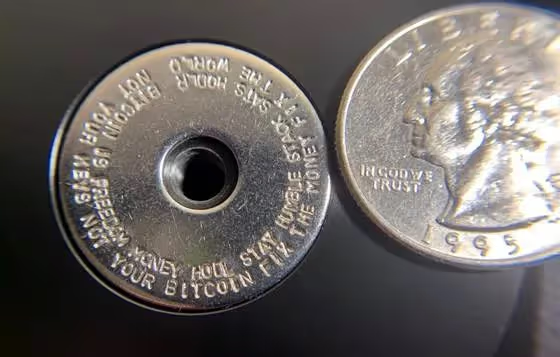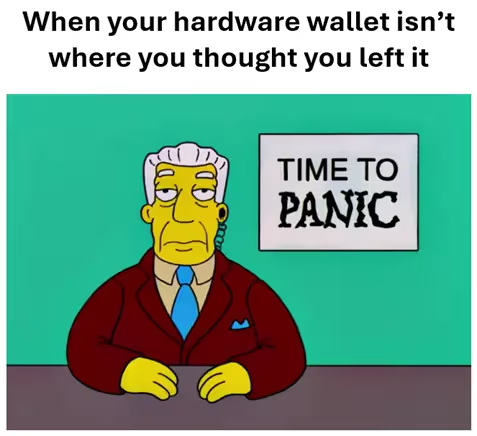Lost or Broken Bitcoin Hardware Wallet? Your Next Steps Explained

In this article:
If you’re subscribed to our newsletter, chances are you’re already using a Bitcoin hardware wallet and understand how important they are as part of your Bitcoin self-custody setup.
But as great as these devices are, the reality is that many people still struggle to fully understand their purpose and the role they play in securing their wealth. For example, a lot of people incorrectly think that their Bitcoin is somehow stored directly ‘in’ or ‘on’ their hardware wallet. You’ll often hear people say things like “I store my Bitcoin on a hardware wallet.”

But that’s not how Bitcoin works. Bitcoins aren’t transferred like files or email attachments and aren’t ‘stored’ on separate physical devices. Bitcoin only exists as a series of entries on a shared ledger. When you transfer Bitcoin, you’re not ‘moving’ it in a physical sense from one device to another, you’re just updating that ledger. Your hardware wallet doesn’t store ‘Bitcoin’; what it stores is a private key that allows you to sign transactions, update the ledger, and attribute Bitcoin from your address to any other address on the network.
This means you can never really ‘lose’ your Bitcoin. It will always exist on the ledger, and you’ll always be able to see it. What you can lose, however, is the private key that allows you to transact with it. If you lose your private key, you didn’t ‘lose’ your Bitcoin, but you did lose your ability to control it.

This might sound like a pedantic distinction to make. Most people would equate losing their private key to losing their Bitcoin. So why split hairs? Well, it’s an important distinction to make because understanding it means you’ll have a better understanding of your hardware wallet, a better understanding of the information you’re trying to keep safe, and ultimately a better understanding of Bitcoin overall.
As we always say, the best way to improve your security is to improve your knowledge.

Most of you will already understand that hardware wallets contain private keys, not Bitcoin, and we aren’t here to teach you to suck eggs. But we do need to address the pervasive idea that hardware wallets should be used for ‘storing’ anything. We know that hardware wallets don’t ‘store’ Bitcoin, but we shouldn’t view them as a suitable way to ‘store’ private keys either.
Like all electronics, hardware wallets sometimes fail, sometimes you lose them, and if you’re really unlucky, sometimes they get stolen. This article will explain why, with the right setup, this should never be a problem, and the next steps you need to take if you do need to replace your hardware wallet.
Don’t Rely on Just Your Bitcoin Hardware Wallet
Hardware wallets would be better understood if they were called ‘signing devices’. They’re useful tools for making secure transactions but should never be the lynchpin of your self-custody setup. If losing your hardware wallet means losing access to your Bitcoin, then you’re definitely doing it wrong.

Your hardware wallet will generate and store your private key for you, but it’s essential that you have it backed up elsewhere in case that hardware wallet fails or becomes lost or stolen. The fate of your private key should not be tied to the fate of your hardware.
The most popular method for doing this?
Backing up your seed phrase by stamping it on metal.
There are a variety of options available from using large steel plates to ultra discreet options that let you stamp 12 to 24 words on a single titanium washer. Whichever route you choose, by backing up your private key appropriately you’ve ensured that you aren’t completely reliant on a single piece of hardware.

With seed phrase backups in place, you’re now in a position to follow some simple protocols to restore access to your Bitcoin wallet even if your hardware wallet is broken, lost, or stolen.
My Bitcoin Hardware Wallet is Broken!
There is every chance that one day you go to use your hardware wallet and discover it either doesn’t turn on at all or has some annoying mechanical fault, like not being able to read SD cards anymore or unresponsive buttons.
Whilst very frustrating, this shouldn’t be a reason to panic so long as your hardware wallet isn’t the only place your private key exists. This is why it’s important to remember that a hardware wallet is just a secure signing device, not a place to ‘store’ private keys.
Provided you still have a copy of your seed phrase, all you need to do is get your hands on a new device and follow the process to ‘restore’ your wallet to it from an already existing seed phrase. In under 5 minutes, you should be back up and running, ready to securely sign transactions again.

Top Tip 1:
Chances are you’ll discover that your hardware wallet has a problem right when you need to use it to make a transaction. If the transaction is urgent enough, you might get tempted to enter your seed phrase into a software wallet to complete the transaction. This is extremely risky business! To avoid finding yourself in that scenario, keeping a backup hardware wallet ready to go means even if your first one fails, you’ll still be able to make secure transactions right away without compromising your security.

Top Tip 2:
If you’re planning on discarding a broken hardware wallet, be sensible about it. There is still a secure element inside it that contains your private key so it’s not wise to leave it lying around or just toss it in the trash.
The best bet would be to destroy it completely rather than putting it in a bin bag next to envelopes with your name and address on.
My Bitcoin Hardware Wallet is Lost or Stolen!
If your hardware wallet malfunctions it can be inconvenient, but with suitable seed phrase backups you aren’t under any serious time pressure to solve the issue. You might be temporarily unable to send secure transactions until you can get a new device, but your funds aren’t at any risk of being compromised.
If, however, your hardware wallet becomes lost or stolen, you need to take a different approach. In this scenario, you need to act swiftly to make sure your funds remain 100% secure.

When your hardware wallet is lost or stolen, you need to assume that whoever ends up in possession of it will likely try to access your funds. Your hardware wallet should ideally be locked with a PIN, giving you some level of protection, but with access to your physical device and the right tools, even this can be circumvented. It’s not likely, but it’s not impossible.
In this scenario, you should move as quickly as possible to set up and transfer your funds to a brand-new wallet by following these steps:
1) Recover your original seed phrase to a new software or hardware wallet. This will allow you to spend funds from your potentially compromised wallet.
2) Create a new wallet with a new seed phrase using either a hardware wallet or software wallet.
3) Transfer all your funds from your old wallet to your new wallet as soon as possible.
4) Take the normal steps to back-up the seed phrase to your new wallet to metal.
Top Tip: This top tip is the same as the previous one…. It makes sense for you to have a backup hardware wallet lying around. When your hardware wallet is lost or stolen, you don’t have the luxury of waiting for a new one to arrive in the post—you should be moving your funds to a new wallet as soon as possible. Without a backup hardware wallet, you will be forced to do this by entering your seed phrase into a software wallet to make the transactions. This is far less secure than restoring your seed to a hardware wallet.

If you’re securing a significant amount of money, it makes sense to spend a couple of hundred dollars to have some backup devices that prevent you from ending up in that situation.
Upgrading Your Bitcoin Hardware Wallet
Sometimes you don’t need to change your hardware wallet for any other reason than you simply want to upgrade it. Perhaps a new model came out with some new features that you like, or you’re swapping from a device made by one manufacturer to another that has a better reputation.

Whatever your motivation for making the upgrade, the steps you will need to follow are the same as the ones you would follow if you were replacing a broken hardware wallet. The only difference is the hardware wallet you’re replacing isn’t broken. Your seed phrase hasn’t been compromised when you upgrade, so you don’t need to transfer funds to a new wallet; you just need to restore your seed phrase to your new and improved device.
While the process for upgrading to a new hardware device is identical to replacing a broken device, there is one important thing to bear in mind. If your old hardware wallet is still operational, then it still contains your private key. If you have no plans to ever use it again, then you should wipe the device and remove the keys from it before disposing of it or keeping it somewhere safe. Good hygiene is essential; you don’t want to leave a trail of devices behind you that have your private keys on them.

Keep Your Bitcoin Secure – The Bitcoin Way
Keeping your Bitcoin secure is all about understanding what you’re doing, why you’re doing it, and being prepared for various situations you might encounter along the way.
If you take the time to master Bitcoin self-custody and develop a good understanding of the tools you’re using, you will be prepared for any situation. Even lost or stolen hardware wallets won’t faze you because you won’t have made the mistake of making them a single point of failure in your setup. You will know how to quickly and easily rectify the situation and carry on about your day.
Developing that level of confidence is a great feeling and we can help you achieve it. Our experts can help you become confident and comfortable securing your Bitcoin in just a handful of sessions.

Holding Bitcoin should give you peace of mind, not cause you stress. Book a free 30-minute call with a member of our team and we can teach you the skills to make your Bitcoin journey more peaceful and more fun.
